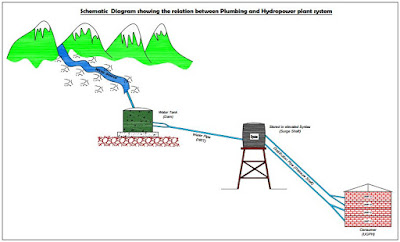Understanding Hydropower System
I understand the Hydropower system similar to the plumbing system arranged at our residence. I tried explaining to everyone who I come in contact but then I can see the dubious face at the end of our talk. They tend to nod their heads with yes, agreed but when questioned, I can see them smiling looking at me. However, I make sure that they are convinced at the end with a happy smile on their face. I want to recapitulate the same statement here and I wish the readers will not misconstrue.
Firstly, I want to take you all to my crazy imaginary world. Okie, now let’s start with the vision that you own a building which has four units and each unit got to have six pipelines connected. The most essential in our home is water so we look for the source of the water high above, for the simple reason that it flows along with the gravity. The water source shall be trapped in the form of a Water Tank built nearby. There may be sediments, foreign substances and it should be settled down before we conduits to our home. To avoid the sediments entering our conduit pipes, we connect the pipes high above the base of the water tank. The clean water will flow through the conduit and it is further stored in the syntax. The location of the syntax may be elevated high on the attic or it can be raised high with the help of a platform. From that point, numerous pipes shall be connected depending upon the users. In our case, two pipes should be sufficient which will be distributed further to four units. Each has got six connections to be made and it will vary depending upon the requirements like in Kitchen, Bathrooms, etc.
Similarly, in Hydropower construction, the process remains the same in a way that it is bigger in size and the purpose is different for it’s for generating electricity. We trap the source of water (Mangdechhu) with the Construction of Diversion Tunnel (8.5m dia, 682m long). The water is stored in the form of Tank and in this case, we have a Concrete Dam (56m above the river bed level, 141.28m long and top width of 10m). The trapped water will then be diverted into two intake tunnels (5m dia, 15m long). The silts and sediments shall be separated when the water is passed through the Desilting Chambers (2 Nos. 14m width, 17.7m height & 340m long). The clean water is then charged through the conduit pipe (HRT, 6.5m dia, 13.52 KM long) and stored in an elevated Syntax (Surge shaft 13.5m dia, 152m deep). Two Nos. 3.5m dia and 1.9km long pressure shaft shall carry the water to Underground Power House cavern (155m long, 23m wide and 41m deep). There it has been bifurcated into four units and each unit is further divided into six nozzles that are responsible for spinning the Pelton Wheel Turbine. The turbines are connected with a shaft so as to rotate the Generator thereby converting the kinetic energy of falling water into mechanical energy. The mechanical energy is thereby converted into electrical energy while rotating around the magnetic field. Each unit has a capacity of producing 180 MW which ultimately will produce 720MW by four units.




Comments